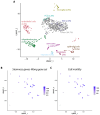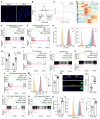KR158 Spheres Harboring Slow-Cycling Cells Recapitulate High-Grade Glioma Features in an Immunocompetent System
- PMID: 38891070
- PMCID: PMC11171638
- DOI: 10.3390/cells13110938
KR158 Spheres Harboring Slow-Cycling Cells Recapitulate High-Grade Glioma Features in an Immunocompetent System
Abstract
Glioblastoma (GBM) poses a significant challenge in clinical oncology due to its aggressive nature, heterogeneity, and resistance to therapies. Cancer stem cells (CSCs) play a critical role in GBM, particularly in treatment resistance and tumor relapse, emphasizing the need to comprehend the mechanisms regulating these cells. Also, their multifaceted contributions to the tumor microenvironment (TME) underline their significance, driven by their unique properties. This study aimed to characterize glioblastoma stem cells (GSCs), specifically slow-cycling cells (SCCs), in an immunocompetent murine GBM model to explore their similarities with their human counterparts. Using the KR158 mouse model, we confirmed that SCCs isolated from this model exhibited key traits and functional properties akin to human SCCs. KR158 murine SCCs, expanded in the gliomasphere assay, demonstrated sphere forming ability, self-renewing capacity, positive tumorigenicity, enhanced stemness and resistance to chemotherapy. Together, our findings validate the KR158 murine model as a framework to investigate GSCs and SCCs in GBM pathology, and explore specifically the SCC-immune system communications, understand their role in disease progression, and evaluate the effect of therapeutic strategies targeting these specific connections.
Keywords: cancer stem cells; glioblastoma; immunocompetent murine model; slow-cycling cells; tumor heterogeneity.
Conflict of interest statement
The authors declare no conflict of interest.
Figures







Update of
-
KR158 spheres harboring slow-cycling cells recapitulate GBM features in an immunocompetent system.bioRxiv [Preprint]. 2024 Jan 30:2024.01.26.577279. doi: 10.1101/2024.01.26.577279. bioRxiv. 2024. Update in: Cells. 2024 May 29;13(11):938. doi: 10.3390/cells13110938. PMID: 38501121 Free PMC article. Updated. Preprint.
Similar articles
-
KR158 spheres harboring slow-cycling cells recapitulate GBM features in an immunocompetent system.bioRxiv [Preprint]. 2024 Jan 30:2024.01.26.577279. doi: 10.1101/2024.01.26.577279. bioRxiv. 2024. Update in: Cells. 2024 May 29;13(11):938. doi: 10.3390/cells13110938. PMID: 38501121 Free PMC article. Updated. Preprint.
-
The reprogramming impact of SMAC-mimetic on glioblastoma stem cells and the immune tumor microenvironment evolution.J Exp Clin Cancer Res. 2025 Jul 4;44(1):191. doi: 10.1186/s13046-025-03452-1. J Exp Clin Cancer Res. 2025. PMID: 40616096 Free PMC article.
-
Glioblastoma stem cells deliver ABCB4 transcribed by ATF3 via exosomes conferring glioblastoma resistance to temozolomide.Cell Death Dis. 2024 May 6;15(5):318. doi: 10.1038/s41419-024-06695-6. Cell Death Dis. 2024. PMID: 38710703 Free PMC article.
-
Glioma Stem Cells as Promoter of Glioma Progression: A Systematic Review of Molecular Pathways and Targeted Therapies.Int J Mol Sci. 2024 Jul 22;25(14):7979. doi: 10.3390/ijms25147979. Int J Mol Sci. 2024. PMID: 39063221 Free PMC article.
-
An update on cancer stem cell survival pathways involved in chemoresistance in triple-negative breast cancer.Future Oncol. 2025 Mar;21(6):715-735. doi: 10.1080/14796694.2025.2461443. Epub 2025 Feb 12. Future Oncol. 2025. PMID: 39936282 Review.
Cited by
-
Treatment Resistant Persister Cells Exploit Macrophage Lipid Metabolism to Sustain Glioblastoma Growth.bioRxiv [Preprint]. 2025 Jun 10:2025.06.07.658345. doi: 10.1101/2025.06.07.658345. bioRxiv. 2025. PMID: 40661379 Free PMC article. Preprint.
-
In vivo mouse models for adult brain tumors: Exploring tumorigenesis and advancing immunotherapy development.Neuro Oncol. 2024 Nov 4;26(11):1964-1980. doi: 10.1093/neuonc/noae131. Neuro Oncol. 2024. PMID: 38990913 Free PMC article. Review.
References
-
- Nicholson J.G., Fine H.A. Diffuse Glioma Heterogeneity and Its Therapeutic Implications. Cancer Discov. 2021;11:575–590. doi: 10.1158/2159-8290.CD-20-1474. - DOI - PubMed
MeSH terms
Grants and funding
LinkOut - more resources
Full Text Sources
Research Materials

